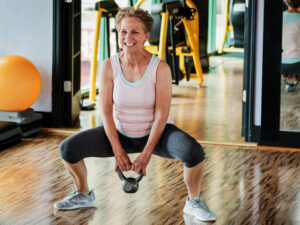
Aging BiologyClinical ResearchFrailtyPhysical Activity
Some people perform incredible feats of strength and endurance well into their retirement years. The great news is: You don’t have to bench press 300 pounds or run a marathon to show off the benefits of strength training.
NIA-supported researchers have been studying the effects of strength training for more than 40 years and have identified multiple ways it can benefit older adults, including maintaining muscle mass, improving mobility, and increasing the healthy years of life.
Age-related mobility limitations are a fact of life for many older adults. Studies have shown that about 30% of adults over age 70 have trouble with walking, getting up out of a chair, or climbing stairs. In addition to making everyday tasks difficult, mobility limitations are also linked to higher rates of falls, chronic disease, nursing home admission, and mortality.
A big culprit for losing our physical abilities as we grow older is the age-related loss of muscle mass and strength, which is called sarcopenia. Typically, muscle mass and strength increase steadily from birth and reach their peak at around 30 to 35 years of age. After that, muscle power and performance decline slowly and linearly at first, and then faster after age 65 for women and 70 for men. Those findings come from NIA’s Baltimore Longitudinal Study of Aging (BLSA) — the longest-running study of human aging — which pioneered a series of simple tests decades ago, known as the Short Physical Performance Battery (SPPB), to track mobility and muscle performance. The SPPB measures an individual’s balance, walking speed, and ability to get out of a chair five times, and then rates that person on a scale of zero to four.
However, such average decline of strength and power with aging can be substantially slowed down by maintaining an active lifestyle. While there is no way to fully “stop the clock,” it’s possible for many older adults to increase muscle strength with exercise, which can help maintain mobility and independence into later life.
NIA scientist Eric Shiroma, Sc.D., has studied the science of exercise for years and is an advocate of activities that add an extra challenge in our daily routines, such as turning a walk into “rucking,” which means wearing a weighted vest or backpack while exercising. He notes that a big key to understanding the range of responses to exercise is knowing how and why our bodies change with age and, perhaps more importantly, how and why these changes can vary from person to person.
“As we get older, there are inevitable functional and biological limitations that can cap exercise endurance, maximum strength, and fitness,” said Shiroma. “Some of these limitations can be slowed down through an active lifestyle that includes strength training. However, it is difficult to study these limits in normal day-to-day life. Studies such as the BLSA are special because scientists can test these limits in the clinic. For example, to test strength and endurance, study participants may be asked to walk or run on a treadmill, or climb stairs, for as long as they can comfortably continue. There are also genetic and environmental components to how people respond to physical challenges and exercise.”
By studying people’s limits and variability, researchers aim to provide older adults with evidence-based advice on how regularly moving and challenging their muscles may help increase their years of optimal health.
